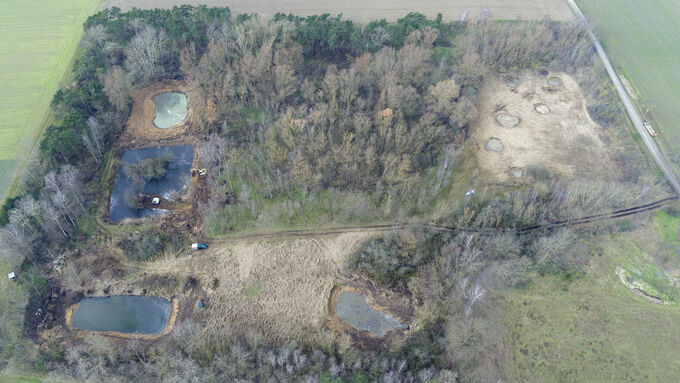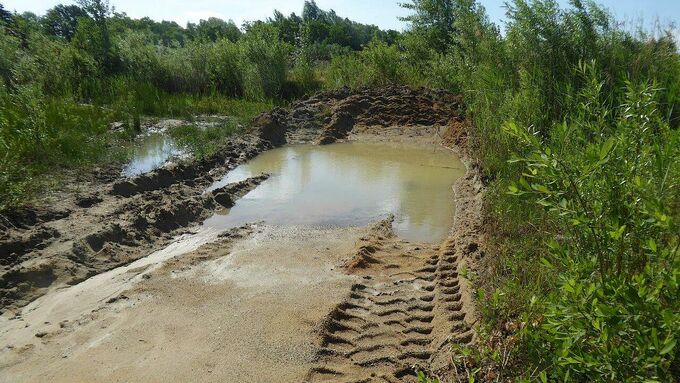Restored amphibian waterbodies in the former gravel pit in Wackerwinkel, photographed from the air © Joachim Neumann
download picturemain content
Project of the month
#6/2023 CONSTRUCTION OF A NETWORK OF SMALL WATERBODIES (REGION HANOVER)
Optimization of habitats for natterjack toad and common spadefoot
In the third project phase of the LIFE IP Atlantic Region DE, a somewhat forgotten gem from an amphibian perspective is being focused on in cooperation with the Lower Nature Conservation Authority of the Region Hanover: the Burgdorf - Lehrte - Uetze area north-east of Hanover. In this area, there is an attractive network of small waterbodies of different origins for amphibians. Numerous active raw material extraction sites which mine gravel, sand or marl are still home for populations of the state-wide rare natterjack toad. The characteristic call of the common spadefoot (blok-blok-blok) can be heard on a hydrophone in waterbodies in finally depleted deposits and waterbodies which have been created as part of compensatory measures (e.g. road construction). Newts populate former fishponds and waterbodies at the edge of forests, sometimes in abundant numbers. Moreover, tree frogs and moor frogs can also be found, although nowhere in population numbers reported years ago. Conservationists are also concerned about the low groundwater levels which have dropped more than 1.5 metres in some areas.
In order to support the described network of waterbodies and its inhabitants, a corresponding action was designed for the third and fourth project phase of the LIFE IP (action C196). The initial 16 sites which were to be investigated and, if necessary, optimized through measures or amphibian-friendly use have now become well over 20 sites. The LIFE IP will not at all sites finance the implementation. Sometimes the Project only provides ideas or advice and third parties carry out the work on their own. The project team is particularly pleased about this, as it is here that the ownership of the locally acting stakeholders kicks in.
So far, the following has been achieved:
- Creation of small waterbodies for the natterjack toad by the company ‘Enge Kies- und Recycling GmbH & Co. KG’ in the sand quarry near Aligse, with successful reproduction of natterjack toads in three consecutive years,
- Removal of woods and restoration of small waterbodies in the sand pit Heeßel by the Lower Nature Conservation Authority of the Region Hanover (common spadefoot, great crested newt, Alpine newt, common newt, water frogs),
- Restoration of a small waterbody in the ‘Burgdorfer Holz’ by the town of Burgdorf (compensatory measure),
- Restoration of a small waterbody in the ‘Burgdorfer Holz’ by the Lower Saxony State Forests under their own responsibility,
- Restoration of four small waterbodies in the ‘Burgdorfer Holz’ by the LIFE IP (three of which are on property of NABU Burgdorf-Lehrte-Uetze and one of which is on property of the Region Hanover). Thanks to targeted watering by the NABU group Burgdorf-Lehrte-Uetze, the development of the natterjack toad tadpoles should have come to a good end despite a rain break for almost six weeks from May onwards.
- Restoration of seven small waterbodies for the natterjack toad and four larger amphibian waterbodies (for the target species great crested newt and sommon spadefoot) in the former gravel pit ‘Wackerwinkel’ near Uetze by the LIFE IP,
- Survey of amphibian populations in the Burgdorf-Lehrte-Uetze area in cooperation with the Lower Nature Conservation Authority of the Region Hanover. In the process, historical sites of the natterjack toad were confirmed and new findings of the common spadefoot were made. Newts were also surveyed in a limited number of waterbodies, with a focus on the great crested newt.
- Support for a Bachelor's thesis on the amphibian populations in the ‘Burgdorfer Holz’. A large number of great crested newts, Alpine newts and common newts were registered. Evidence of the reproduction of the natterjack toad and the occurrence of the European tree frog was found.
The surveys and the planning of measures will be continued. In winter 2023/2024, further waterbodies in the ‘Burgdorfer Holz’ are to be restored. If necessary, further improvements for endangered species can be achieved by providing advice to active extraction sites. The big issue for the future, however, is how to deal with water in the landscape and agricultural drainage adapted to climatic changes. This must now accomplish two things: retain as much water as possible in the landscape and make it possible to cultivate the land by deliberately lowering the water table at the same time.





